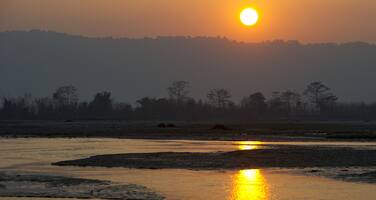Chitwan National Park
Factors affecting the property in 1997*
- Illegal activities
- Management systems/ management plan
Factors* affecting the property identified in previous reports
- Proposed irrigation project to divert the Rapti river (issue resolved)
- Poaching
- Outdated Management plan
International Assistance: requests for the property until 1997
Total amount approved : 80,000 USD
| 1989 | Public awareness programmes and development of an ... (Approved) | 50,000 USD |
| 1988 | Consultancy services for the preparation of a plan for ... (Approved) | 30,000 USD |
Missions to the property until 1997**
Information presented to the Bureau of the World Heritage Committee in 1997
The Director of the Royal Chitwan National Park submitted a report on the state of conservation of this site at the Meeting of the South Asian World Natural Heritage Site Managers held in New Delhi and Keoladeo National Park, during 16-19 January 1997. This Park has a population of more than 400 greater one-horned rhinoceros and is a success story similar to Kaziranga National Park (India) referred to earlier in this document. Part of this success is attributable to the fact that the Nepalese Army assists the staff of the Royal Chitwan National Park in anti-poaching activities.
Discussions during the South Asia Meeting revealed that 80 % of the total population (i.e. about 2,000) of the greater one-horned rhinoceros, a species restricted in its range to South Asian countries, are found in the World Heritage sites of Kaziranga (India; 1,200) and Royal Chitwan (Nepal; 400). Intensive poaching can quickly lead to sharp declines in Rhino populations, as in the World Heritage area of Manas (India) (please refer to document WHC-97/CONF.204/2A). Increased cooperation between the staff of these three World Heritage sites were called for by the Managers of the respective sites, with regard to sharing of intelligence information on trading routes of rhino horns and the activities of commercially motivated poaching gangs, with a view to ensuring continuity of the role which these three World Heritage sites have played in the protection of South Asia's greater one-horned rhinoceros.
The management of Royal Chitwan has introduced several measures to reduce conflicts with local villagers, largely arising from crop damage caused by wild animals. Villagers are allowed to collect grasses for roof-thatching and for use as fodder for livestock. In addition, villages around the Park receive 50% of the revenues generated through tourism to the Park for use in rural development initiatives. In December 1996, the Royal Chitwan National Park signed a cooperative agreement with Dartmoor National Park of the United Kingdom, under the European Union Funded Partnership and Exchange Programme which enables staff exchanges, study visits and training programmes.
Action Required
The Bureau recognizes the role which Royal Chitwan of Nepal and Kaziranga of India continue to play in conserving the greater one-horned rhinoceros in South Asia, and encourages the Centre to cooperate with the States Parties and the CITES Convention for sustaining the successes achieved to-date.
Summary of the interventions
Decisions adopted by the Committee in 1997
21 BUR IV.B.28
Royal Chitwan National Park (Nepal)
The Bureau noted with satisfaction that this site has a population of more than 400 great one-horned rhinoceros and its success is partly attributable to the cooperation between the Nepalese Army and the staff of the Royal Chitwan National Park in anti-poaching activities.
The Bureau was informed that 80% of the total population (i.e. about 2,000) of the great one-horned rhinoceros, a species restricted in its range to South Asia, are found in the World Heritage sites of Kaziranga (India; 1,200) and Royal Chitwan (Nepal; 400). The Bureau, however, noted that intensive poaching can quickly lead to sharp declines in rhino populations, as observed in the World Heritage area of Manas (India), a site included in the List of World Heritage in Danger.
The Bureau encouraged the Centre to facilitate cooperation between the staff of Royal Chitwan (Nepal) and Kaziranga and Manas (India) World Heritage sites, and the CITES Convention for sharing of intelligence information on trading routes of rhino horns and the activities of commercially motivated poaching gangs in order to sustain the contributions which World Heritage sites have made to rhino conservation in South Asia.
* :
The threats indicated are listed in alphabetical order; their order does not constitute a classification according to the importance of their impact on the property.
Furthermore, they are presented irrespective of the type of threat faced by the property, i.e. with specific and proven imminent danger (“ascertained danger”) or with threats which could have deleterious effects on the property’s Outstanding Universal Value (“potential danger”).
** : All mission reports are not always available electronically.


